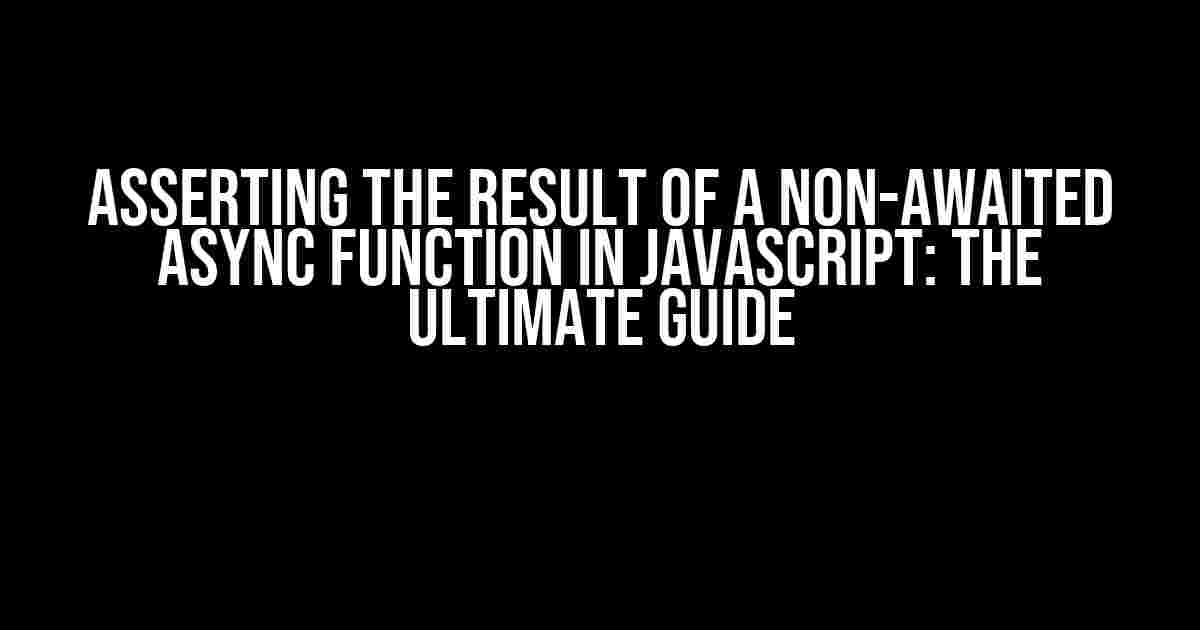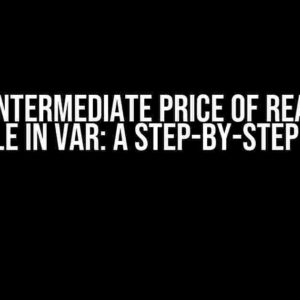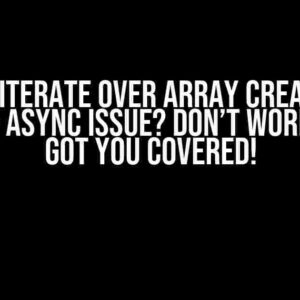Asynchronous programming in JavaScript can be a real challenge, especially when it comes to asserting the result of a non-awaited async function. If you’re stuck in the dark ages of callback hell or struggling to grasp the concept of async/await, fear not! This article will take you by the hand and guide you through the process of asserting the result of a non-awaited async function in JavaScript.
What’s the Problem with Non-Awaited Async Functions?
In JavaScript, async functions return a promise, which is a result object that is used to handle asynchronous operations. When you call an async function, it returns immediately, without blocking the execution of the code. This is great for performance, but it can make it tricky to assert the result of the function, especially when you’re not using the await keyword.
The Problem with Callbacks
In the past, developers used callbacks to handle asynchronous operations. A callback is a function that is passed as an argument to another function, and is executed when a specific operation is completed. The problem with callbacks is that they can lead to “callback hell,” where you have multiple nested callbacks that make your code hard to read and maintain.
function asyncFunction(callback) {
setTimeout(function() {
callback("Result");
}, 2000);
}
asyncFunction(function(result) {
console.log(result);
asyncFunction(function(result) {
console.log(result);
asyncFunction(function(result) {
console.log(result);
});
});
});
As you can see, callbacks can lead to a lot of nesting and make your code look like a mess. This is where async/await comes in.
Async/Await to the Rescue
Async/await is a syntax sugar on top of promises that allows you to write asynchronous code that looks and feels like synchronous code. When you use async/await, you can write code that is easier to read and maintain.
async function asyncFunction() {
return new Promise((resolve) => {
setTimeout(() => {
resolve("Result");
}, 2000);
});
}
async function main() {
const result = await asyncFunction();
console.log(result);
const result2 = await asyncFunction();
console.log(result2);
const result3 = await asyncFunction();
console.log(result3);
}
main();
As you can see, async/await makes your code look much cleaner and easier to read. But, what happens when you’re not using async/await? How do you assert the result of a non-awaited async function?
Asserting the Result of a Non-Awaited Async Function
To assert the result of a non-awaited async function, you need to use a promise chain. A promise chain is a sequence of promises that are linked together, where each promise returns a value that is passed to the next promise in the chain.
function asyncFunction() {
return new Promise((resolve) => {
setTimeout(() => {
resolve("Result");
}, 2000);
});
}
asyncFunction().then((result) => {
console.log(result);
return asyncFunction();
}).then((result) => {
console.log(result);
return asyncFunction();
}).then((result) => {
console.log(result);
});
In this example, we’re using a promise chain to assert the result of the asyncFunction. Each time the asyncFunction resolves, we log the result to the console and return the next promise in the chain.
Using Promise. then()
The then() method is used to handle the result of a promise. It takes a callback function as an argument, which is executed when the promise is resolved or rejected.
asyncFunction().then((result) => {
console.log(result);
}, (error) => {
console.error(error);
});
In this example, we’re using the then() method to log the result to the console when the promise is resolved, and to log an error to the console when the promise is rejected.
Using Promise.catch()
The catch() method is used to handle errors in a promise chain. It takes a callback function as an argument, which is executed when an error occurs in the promise chain.
asyncFunction().then((result) => {
console.log(result);
}).catch((error) => {
console.error(error);
});
In this example, we’re using the catch() method to log an error to the console when an error occurs in the promise chain.
Best Practices for Asserting the Result of a Non-Awaited Async Function
Here are some best practices to keep in mind when asserting the result of a non-awaited async function:
- Always return a promise from your async function.
- Use promise chains to handle the result of your async function.
- Use the then() method to handle the result of your async function.
- Use the catch() method to handle errors in your promise chain.
- Avoid using callbacks, as they can lead to callback hell.
Common Pitfalls to Avoid
Here are some common pitfalls to avoid when asserting the result of a non-awaited async function:
-
Not returning a promise from your async function.
If you don’t return a promise from your async function, you won’t be able to use a promise chain to handle the result.
-
Not using a promise chain to handle the result.
If you don’t use a promise chain, you won’t be able to handle the result of your async function in a clean and efficient way.
-
Not using the then() method to handle the result.
If you don’t use the then() method, you won’t be able to handle the result of your async function in a promise chain.
-
Not using the catch() method to handle errors.
If you don’t use the catch() method, you won’t be able to handle errors in your promise chain.
-
Using callbacks instead of promises.
Callbacks can lead to callback hell, which can make your code hard to read and maintain.
Conclusion
Asserting the result of a non-awaited async function in JavaScript can be a challenge, but with the right techniques and best practices, you can write clean and efficient code that is easy to read and maintain. By using promise chains, the then() method, and the catch() method, you can handle the result of your async function in a promise chain. Remember to avoid common pitfalls, such as not returning a promise from your async function, not using a promise chain, and using callbacks instead of promises.
| Technique | Description |
|---|---|
| Promise Chain | A sequence of promises that are linked together, where each promise returns a value that is passed to the next promise in the chain. |
| Used to handle the result of a promise. | |
| catch() Method | Used to handle errors in a promise chain. |
| Async/Await | Syntax sugar on top of promises that allows you to write asynchronous code that looks and feels like synchronous code. |
By following the techniques and best practices outlined in this article, you’ll be well on your way to becoming a master of asserting the result of a non-awaited async function in JavaScript.
Further Reading
If you want to learn more about async/await, promises, and asynchronous programming in JavaScript, here are some resources to check out:
I hope this article has helped you understand how to assert the result of a non-awaited async function in JavaScript. Happy coding!
Frequently Asked Question
If you’re struggling to grasp the concept of asserting the result of a non-awaited async function in JavaScript, don’t worry, you’re not alone! Here are some frequently asked questions that’ll help you get a better grip on this tricky topic.
Q: What happens when I don’t await an async function in JavaScript?
When you call an async function without awaiting it, the function returns a promise immediately, and the execution continues to the next line of code. This means you won’t get the final result of the async function, and you might end up with unexpected behavior or errors.
Q: How can I assert the result of a non-awaited async function in a testing environment?
In a testing environment, you can use a library like Jest or Mocha to assert the result of a non-awaited async function. For example, in Jest, you can use the `expect.toEqual` method to assert that the returned promise resolves to the expected value.
Q: Can I use try-catch blocks to handle errors in non-awaited async functions?
Nope! Try-catch blocks only catch synchronous errors, not asynchronous ones. To handle errors in non-awaited async functions, you need to use `.catch()` method or `try-catch` blocks inside an async function.
Q: Why can’t I use `async/await` with a non-awaited async function?
You can’t use `async/await` with a non-awaited async function because `await` only works within an async function. If you try to use `await` outside an async function, you’ll get a syntax error.
Q: Are there any workarounds to assert the result of a non-awaited async function without using `await` or `.then()`?
Yes! One workaround is to use a library like `p-queue` or `bluebird` which provides a way to promisify the result of an async function. Another approach is to use a setTimeout function to wait for the async function to complete, but this approach is generally considered an anti-pattern.







